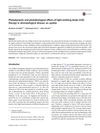Response of Distinct Human Dermal Fibroblast Lineages to Visible Radiation: Potential for Differential Light-Based Therapy
September 2017
in “
The journal of investigative dermatology/Journal of investigative dermatology
”
TLDR Different types of human skin cells respond uniquely to various colors and doses of light, which could lead to specialized light treatments for skin conditions.
This study investigated the response of primary human papillary and reticular dermal fibroblasts (DF) to visible light, focusing on metabolic activity, collagen synthesis, reactive oxygen species (ROS) production, and gene expression. The results showed that a single exposure to 450nm light at doses ≤30 J/cm2 stimulated DF, while consecutive daily treatments ≥30 J/cm2 had inhibitory or cytotoxic effects. Blue light (450nm) induced a dose-dependent ROS release and inhibited pro-collagen production, particularly in reticular DF, which also exhibited greater sensitivity at the gene expression level. Conversely, 850nm near-infrared (NIR) light (20 J/cm2) stimulated metabolic activity without causing ROS formation and upregulated protein synthesis and metabolic pathways, with reticular DF being more responsive. These findings suggested potential for differential light-based therapies for various skin conditions.




